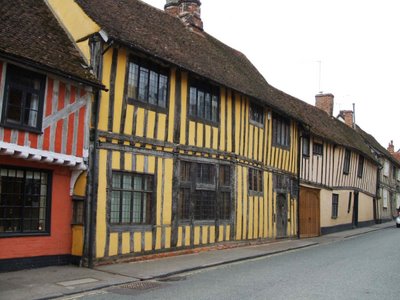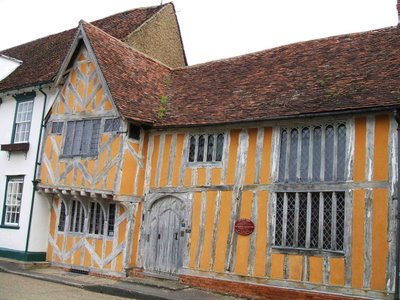 As you might have guessed, I have figured out how to upload pictures from my new digital camera to the computer. Here are some pics from my recent trip to England — houses in Lavenham, Suffolk. I love the colors!!! I’ve never been a fan of the greenish-brown brick that so many English houses have, so I just adore all the colors in Suffolk.
As you might have guessed, I have figured out how to upload pictures from my new digital camera to the computer. Here are some pics from my recent trip to England — houses in Lavenham, Suffolk. I love the colors!!! I’ve never been a fan of the greenish-brown brick that so many English houses have, so I just adore all the colors in Suffolk.
And then the half timbering — there’s SO much in Lavenham that it’s amazing. It’s really like going back in time — except for all the cars, of course. 🙂  Though to be correct, I should mention that during my trip in Lavenham I learned that “half-timbered” is not the general term for these buildings — actually, “half-timbered” refers to the buildings in which the timbers are so wide that half of each wall is wood. (So most of the buildings people refer to as “half-timbered” aren’t. Perhaps they’re quarter-timbered? 32 percent timbered? 0.2119 timbered?)
Though to be correct, I should mention that during my trip in Lavenham I learned that “half-timbered” is not the general term for these buildings — actually, “half-timbered” refers to the buildings in which the timbers are so wide that half of each wall is wood. (So most of the buildings people refer to as “half-timbered” aren’t. Perhaps they’re quarter-timbered? 32 percent timbered? 0.2119 timbered?)
Ahem. Sorry about that.
During the Middle Ages, Lavenham was a prosperous wool town. The wealthy merchants built these houses to live in — these were prestigious homes back then, and those with the most wood were the most admired. Even Queen Elizabeth visited Lavenham in 1578, bringing her whole court. (Wouldn’t that be nice, having folks like that drop in on you, expecting you to feed them all at your own great expense?)
By the end of the century, though, the wool trade in Lavenham started to decline (perhaps Elizabeth’s court ate too much?) Eventually, Lavenham turned into a quiet little byway, no longer important in the economy of the nation, or even the county. This meant that instead of tearing down all these beautiful timbered buildings to put up factories and more modern dwellings, most folks didn’t have the money for serious improvements or modernizations — so Lavenham is almost untouched. There are over three hundred buildings in Lavenham which have been listed as being of historical or architectural significance.
So: which of these would you want to be your house, or your Regency heroine’s house? (During the Georgian period, many of these houses were covered with brick — but our heroines, of course, can live in pink houses if we want.)
Pink, orange, red, yellow, beige, white — what color would you paint your house? Would you have white-ish timbers, as in the bottom photo here (which is apparently how they originally did them), or would you paint or stain them black or brown? Or would Lavenham just be too colorful a town for you?
Inquiring minds want to know!
Cara
Cara King — www.caraking.com
MY LADY GAMESTER — Booksellers’ Best Finalist for Best Regency of 2005!

I could paint the building for my school colors–but which school?? Green and white? Crimson? Orange and black? Blue? Blue and gold? Tartan? Red and white? Cardinal and gold?
No, no, it’s too difficult. I need to lie down for a while. I hope those 0.492-timbered buildings have beds in them…
Todd-who-has-been-at-way-too-many-schools
I would have stone, dark grey stone and then the dark wood detailing but only on the top, I’ve seen quite a bit of manours that way that had been from the medeival times, which is quite beautiful, and mysterious in ways.
I would like the loudest color combination possible. I do love pink and brown (the new black!), so maybe I’d go for that. That’s not too loud. Thanks for sharing the photos, Cara.
I love these houses! What an adorable town. I would definitely paint my house pink, because I think everything should be pink. 🙂
Looks like you had a great trip! I love the orange house. I think I’d have to have that one if I was allowed to choose.
Well, there is always the New York Mets colors of orange and blue. . . LOL I guess I would go with a tan/brown and I want to say black for the rest. . . hard to say, can’t picture it. 🙂
Lois
I’d live in the pink house during the Regency period but wouldn’t I smell of trade. However, in the Georgian periold I would live in the orange one. I like that door!
Uh, I think I read somewhere that they got those lovely pinks from mixing animal blood into the plaster. Waste not, want not.
Good pix, Cara-hardly a car or human being in sight!
Janet
I’m with Amanda! I want pink!
During the Middle Ages, like Lavenham, Lacock in Wiltshire was also a prosperous wool town.
The National Trust site says that Lacock Village dates back to the 13th-century and remains largely unchanged over the centuries with many limewashed, half-timbered, and stone houses.
Cara, the house shown in the photo above has a different timbering style from the houses in Lavenham. However, even this one doesn’t show the “half timber wall.” Looks like any dark wood pieces showing through the outer wall is referred to as half-timbered these days.
If the paint is made with oxblood, is there a local problem with vampires licking the outside of the houses? If so, I think I’ll pass on the pink ones…
Todd-whose-inquiring-mind-wants-to-know
I checked out your link, Keira, but I didn’t see the timbered house you were referring to! In any case, I doubt we really disagree here — “half-timbered” is definitely the colloquial term, but apparently architects and historians et al use the term more narrowly than the masses.
There was one building in Lavenham (one of the guildhalls) that was actually half timbered. I didn’t put up the photo, though! But here’s the URL of a pic of it:
http://www.kemp77.freeserve.co.uk
/guildhall.htm
The building that makes up the right 2/3 or so of the pic is supposed to be actually half-timbered. It definitely has less space between the timbers than some of the pics I put on the blog!
BTW, my house might be pink too. (I do like the pink and black together!) But I like the yellow as well.
Cara
Wouldn’t a half-timbered house just be Tim’s house? Ber’s house would just be silly, of course.
Thanks for those pics, Cara!
I am not sure what colors I’d choose. I love turquoise with brown but that would stand out a bit, wouldn’t it? 🙂